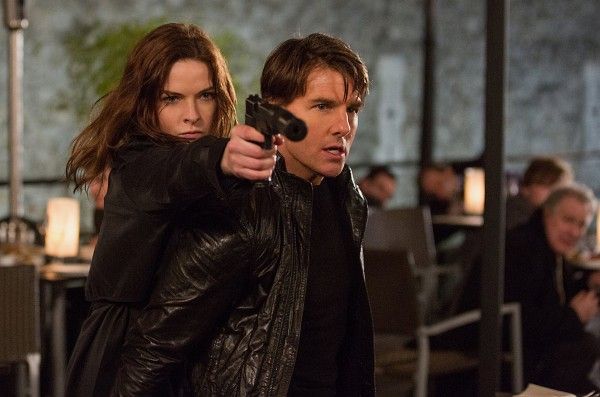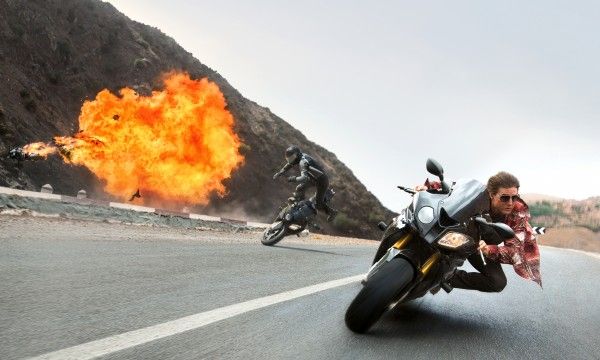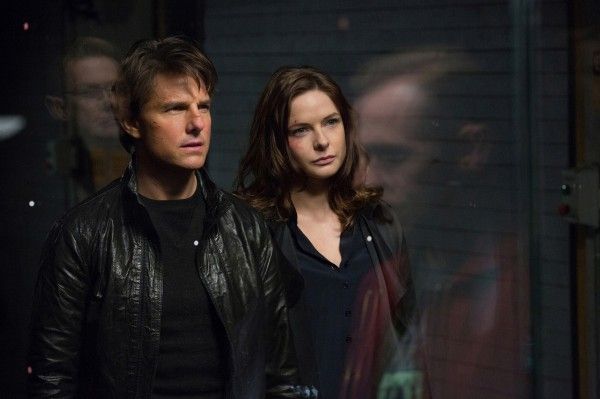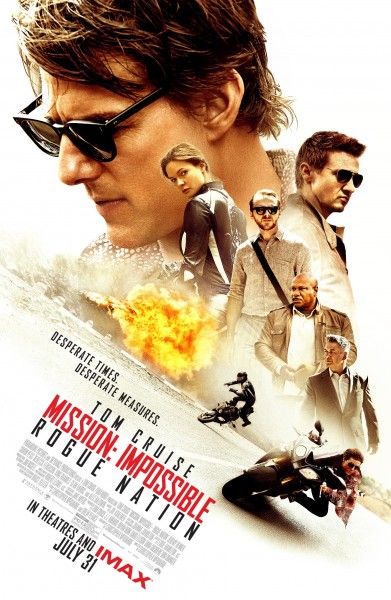Mission: Impossible – Ghost Protocol was about a team working to stop the apocalypse with nothing but spit and duct tape. It was Murphy’s Law in motion, and it made for an exhilarating ride that cemented the team dynamic while providing fresh life to the series. And yet one of the best things about the Mission: Impossible franchise thus far is that it’s almost impossible to pin down. The entries may share similarities—find the MacGuffin, Ethan gets disavowed, incredible stunts—but they each have a different feel and tone. Tom Cruise is the glue that holds it all together, but the films make no attempt to replicate each other. And yet you can go from something as purposely rickety as Ghost Protocol to something as suave and sophisticated as Mission: Impossible – Rogue Nation without ever missing a beat.
When Mission: Impossible 2 came along, it was too early to establish an anti-anything, and yet they went ahead and tried to create an anti-Ethan Hunt. It didn’t really work. But five movies in, the world has been well-defined enough that evil versions can come along make for an interesting dynamic. Hence the arrival of The Syndicate, an “anti-IMF” bent on fostering death and destruction worldwide to achieve its own ends. Ethan is on the run from the get-go, captured by the Syndicate and quickly disavowed by an IMF that threatens to be swallowed up by CIA director Alan Hunley (Alec Baldwin), who believes Hunt is both “arsonist and fireman”, setting up threats that only he can eliminate. However, the real threat is Solomon Lane (Sean Harris), who oversees the Syndicate and has plans to steal a Redbox (not the DVD rental service), which contains financial assets that could fund his terrorist network for decades.
What’s most remarkable about Rogue Nation and what it shows about the Mission: Impossible franchise is that there’s no series quite as elastic or dynamic running right now. Marvel movies can jump between genres, but they have to maintain a similar visual style and hold to certain rules. The Fast & Furious movies don’t even resemble how they started out, and while they uphold some notion of family, it’s a series that has had to grow and adapt. Meanwhile, the Mission: Impossible series, which has been around since 1996, still has the same core while maintaining the flexibility to do something completely different almost twenty years after it began.
No one would mistake Rogue Nation for any of the other four Mission movies, and writer/director Christopher McQuarrie cleverly plays to the series’ strength while forging a new, romantic, sweeping tone for the series. There are still the Mission signposts of Hunt engaging in some physically demanding feats of derring-do complete with a MacGuffin, an antagonist bent on world destruction, and the IMF kicking Hunt out yet again (the only one where he seems to remain part of the agency for the entire film is Mission: Impossible 2), and yet McQuarrie instills everything with a Hitchcockian flair, creating a magnificent blend of classic style with modern blockbuster thrills.
You can see this blend come to life in the opera house sequence, which has so many moving parts, and yet remains elegant and well-defined throughout. Think back to Mission: Impossible III where everything is hard-charging, handheld shoot-em-ups with a bit of espionage thrown in (even taking Owen Damian is done at gunpoint), and how it contrasts with the musical, methodical pacing of the opera house in Rogue Nation. Even when McQuarrie ups the action to above a whisper like he does in the motorcycle chase, it’s all about precision. There’s nothing sloppy or improvised even if, as Rogue Nation astutely points out, Hunt is a gambler who gets lucky most of the time.
Rogue Nation is not the kind of movie this franchise started out as, and if back in 1996 you had asked for a vision for what Mission: Impossible could be, I doubt Cruise or his fellow producers would have been able to define how this all shook out. And yet it’s a series that almost always knows the right chances to take and how to evolve. Take, for example, the character of Ilsa Faust (Rebecca Ferguson). It took five movies to introduce an external, non-IMF character who is truly Hunt’s equal, and yet McQuarrie wisely doesn’t try to make her into the Female Ethan Hunt. Instead, he drew up someone new from scratch and added an entirely new angle to the series.
What’s magnificent about Faust is that she’s her own agent with her own goals, and her story happens to intersect with Hunt’s. She’s not recruited by Hunt like Nyah in Mission: Impossible 2 nor is her greatest asset her femininity. If Paramount wanted to, they could spin Ilsa Faust off into her own franchise and people would happily show up because she’s such a cool, distinctive character who always keeps you guessing with her allegiances. Ferguson knows how to play enigmatic, and while we’re rooting for Faust to team up with Hunt, we can never be completely sure until the end that she’s with the good guys. The structure of the movie may belong to Ethan, but its tone and confidence are with Ilsa.
The way the Mission: Impossible franchise can seamlessly switch between these radically different tones and yet feel like part of one gigantic series is unheard of in blockbuster franchise filmmaking. Yes, there are elements that sometime get shortchanged (it isn’t until the sixth installment that the movie finally codifies Hunt’s character rather than leaving him as an action hero cipher), but overall, the movies, even at their weakest, are kind of a miracle of blockbuster filmmaking. It’s been riveting to watch this series grow, evolve, and change. Fittingly, it knows how to wear different masks. Sometimes it’s the mask of a seductive thriller, other times it’s the mask of a slam-bang action movie. But beneath it all, you have Ethan Hunt choosing to accept his mission and saving the world.
Tomorrow: My review of Mission: Impossible – Fallout.
Previous entries:
- Mission: Impossible
- Mission: Impossible 2
- Mission: Impossible III
- Mission: Impossible – Ghost Protocol





